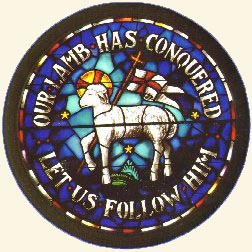
For over five centuries the
Moravian Church has proclaimed the gospel
in all parts of the world. Its influence
has far exceeded its numbers as it has
cooperated with Christians on every
continent and has been a visible part of
the Body of Christ, the Church. Proud of
its heritage and firm in its faith, the
Moravian Church ministers to the needs of
people wherever they are.
The name Moravian
identifies the fact that this historic
church had its origin in ancient Bohemia
and Moravia in what is the present-day
Czech Republic. In the mid-ninth century
these countries converted to Christianity
chiefly through the influence of two
Greek Orthodox missionaries, Cyril and
Methodius. They translated the Bible into
the common language and introduced a
national church ritual. In the centuries
that followed, Bohemia and Moravia
gradually fell under the ecclesiastical
jurisdiction of Rome, but some of the
Czech people protested.
The foremost of Czech
reformers, John Hus (1369-1415) was a
professor of philosophy and rector of the
University in Prague. The Bethlehem
Chapel in Prague, where Hus preached,
became a rallying place for the Czech
reformation. Gaining support from
students and the common people, he led a
protest movement against many practices
of the Roman Catholic clergy and
hierarchy. Hus was accused of heresy,
underwent a long trial at the Council of
Constance, and was burned at the stake on
July 6, 1415.
ORGANIZED IN
1457
The reformation spirit did not
die with Hus. The Moravian Church, or Unitas
Fratrum (Unity of
Brethren), as it has been officially
known since 1457, arose as followers of
Hus gathered in the village of Kunvald,
about 100 miles east of Prague, in
eastern Bohemia, and organized the
church. This was 60 years before Martin
Luther began his reformation and 100
years before the establishment of the
Anglican Church. By 1467 the Moravian
Church had established its own ministry,
and in the years that followed three
orders of the ministry were defined:
deacon, presbyter and bishop.
GROWTH,
PERSECUTION, EXILE
By 1517 the Unity of Brethren
numbered at least 200,000 with over 400
parishes. Using a hymnal and catechism of
its own, the church promoted the
Scriptures through its two printing
presses and provided the people of
Bohemia and Moravia with the Bible in
their own language.
A bitter persecution, which
broke out in 1547, led to the spread of
the Brethren's Church to Poland where it
grew rapidly. By 1557 there were three
provinces of the church: Bohemia, Moravia
and Poland. The Thirty Years War
(1618-1648) brought further persecution
to the Brethren's Church, and the
Protestants of Bohemia were severely
defeated at the battle of White Mountain
in 1620.
The prime leader of the Unitas
Fratrum in these
tempestuous years was Bishop John Amos
Comenius (1592-1670). He became
world-renowned for his progressive views
of education. Comenius, lived most of his
life in exile in England and in Holland
where he died. His prayer was that some
day the "hidden seed" of his
beloved Unitas Fratrum might once again
spring to new life.
RENEWED IN THE
1700s
The eighteenth century saw the
renewal of the Moravian Church through
the patronage of Count Nicholas Ludwig
von Zinzendorf, a pietist nobleman in
Saxony. Some Moravian families fleeing
persecution in Bohemia and Moravia found
refuge on Zinzendorf's estate in 1722 and
built the community of Herrnhut. The new
community became the haven for many more
Moravian refugees. Count Zinzendorf
encouraged them to keep the discipline of
the Unitas Fratrum,
and he gave them the vision to take the
gospel to the far corners of the globe.
August 13, 1727, marked the culmination
of a great spiritual renewal for the
Moravian Church in Herrnhut, and in 1732
the first missionaries were sent to the
West Indies.
TO AMERICA IN
1735
After an unsuccessful attempt
to establish a Moravian settlement in
Georgia (1735-1740), the Moravians
settled in Pennsylvania on the estate of
George Whitefield. Moravian settlers
purchased 500 acres to establish the
settlement of Bethlehem in 1741. Soon
they bought the 5,000 acres of the Barony
of Nazareth from Whitefield's manager,
and the two communities of Bethlehem and
Nazareth became closely linked in their
agricultural and industrial economy.
Other settlement congregations were
established in Pennsylvania, New Jersey
and Maryland. All were considered
frontier centers for the spread of the
gospel, particularly in mission to the
Native Americans.
Bishop Augustus Spangenberg
led a party to survey a 100,000 acre
tract of land in North Carolina, which
came to be known as Wachau
after an Austrian estate of Count
Zinzendorf. The name, later anglicized to
Wachovia, became the center of growth for
the church in that region. Bethabara,
Bethania and Salem (now Winston-Salem)
were the first Moravian settlements in
North Carolina.
Bethlehem in Pennsylvania and
Winston-Salem in North Carolina became
the headquarters of the two provinces
(North and South), which developed as the
Moravian Church in North America became
established as an autonomous church body
after the Unity Synod of 1848. The church
spread out from the geographical centers
of Bethlehem and Winston-Salem, following
German emigrants to the Midwest. At the
end of the nineteenth century they
responded to the spiritual needs of
Moravian refugees of German ancestry who
were fleeing to western Canada because of
persecution in Eastern Europe. Such wide
geographical spread caused the Northern
Province to be divided into Eastern,
Western and Canadian Districts.
After World War II, strong
pushes for church extension took the
Northern Province to Southern California
(where only an Indian mission had existed
since 1890) as well as to some Eastern,
Midwestern and Canadian sites. The
Southern Province added numerous churches
in the Winston-Salem area, throughout
North Carolina and extended its outreach
to Florida and to Georgia. In North
America, the Moravian Church has
congregations in 16 states, the District
of Columbia, and in two Provinces of
Canada.
[courtesy
of The Moravian Church in North
America]
[See also: Moravian Church links]
|